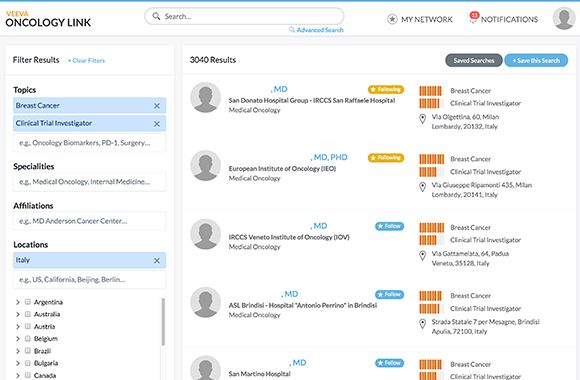Linking in with Oncology KOLs
Kilian Weiss, Veeva Oncology Link General Manager, talks about how the Oncology Link offering has evolved and how it facilitates the process of identifying and approaching key opinion leaders.
Veeva Oncology Link is an enterprise source of continuously updated oncology market intelligence aimed at facilitating better planning and engagement. It consolidates tens of thousands of experts and millions of activities worldwide into a single, complete source for medical and commercial use, offering “better coordination and alignment around the scientific experts who can make or break the success of a drug”. Essentially, it offers a technology solution, removing much of the subjectivity from the process of selecting and engaging with KOLs.
Originally launched in June 2018, the tool has evolved in its early months with input from its early adopters to offer a streamlined experience providing a comprehensive and easily accessible source of oncology expert information, allowing users to visualize their personal network of local, national, and global experts, understand scientific collaborations, and receive notifications to stay informed about ongoing interactions and activities. One adopter, a major mid-sized pharma company, told Pharm Exec that the tool has enabled them to cut their direct spend on these data activities by 50%.
Pharm Exec caught up again this month with Kilian Weiss, Veeva Oncology Link General Manager, to talk about how the offering has evolved and how it facilitates the process of identifying and approaching oncology key opinion leaders (KOLs).
Pharm Exec: Can you outline what Veeva Oncology Link is and how a company can use it?
Kilian Weiss

Kilian Weiss: It’s a data platform, tightly integrated with our software; you can access the data via our Oncology Link software or via our CRM platform. You have access to 100.000 of KOL profiles and you can identify and search for experts. For example, if you wanted to build an advisory board around very specific biomarkers in China, it used to take months to find these experts; now it can be done in seconds, and the profile are always up to date.
By having a globally unified data platform, our customers can see who else is doing things, who else is focusing on specific experts, so they can manage and co-ordinate across their company accordingly. That’s good for the company because it means it can engage in the right way with experts and not use them for small and maybe less relevant projects when another team might need their strategic guidance for a bigger, more important project. So it drives a better customer experience.
Basically, the tool is like LinkedIn. Just that we make the data. Imagine you are like a global marketing executive at a top pharma company, and you’re dealing with all these tumor types and teams and functions, it's hard for you to build your strategy, to make decisions. With Oncology Link, you can instantly tap into KOL profiles, determine their global relationships, who they are following on social media, what papers they have published, which conferences they have attended and spoken at. You can adjust your marketing strategy and commercial decisions based on that knowledge and can really connect the high-level marketing engine with what's going on in the field. The tool is easy to use, there's no user management, everyone in the company can register to use it. Once you get access, you can begin using it straight away.
It’s really critical for the industry because KOLs drive innovation, patient outcomes, and global health policy, and they shape how local physicians adopt innovative new products. The reason the industry needs it now is because the large oncology market is growing in complexity, with combination therapies and increasingly personalized treatments. It is very difficult for everyone to absorb that complexity; scientific experts help physicians, patients, payers and policy makers to translate it into clinical science. But the traditional tools to engage with these experts have been very fragmented. In today’s globally connected world, it is not sufficient anymore for every team in a pharma company to have that fragmented view. An enterprise needs to have the capability to know what is happening with KOLs globally and to engage with them in a very qualified way. Oncology Link builds the foundation for this process.
Having been announced in late 2017, Oncology Link was relaunched at Veeva’s Commercial & Medical Summit in Madrid in November 2018. What features does the relaunched tool offer?
What we did fundamentally is change the whole model around stakeholder data, moving from a fragmented, project-specific approach to a curated, LinkedIn-type subscription platform. The first thing we had focused on, for around the first years of Oncology Link’s development, was to build up the data stream and make this available to the market. What we saw was that people liked it and they efficiency by using the platform unify what used to be lots of little projects that were expensive. But it didn't really unlock the full potential of this data; we felt we needed a new user interface to achieve this. We worked with the early adopters to validate the tool, and this validated relaunch is what was made available to the market at last year’s Veeva Summit. It was the result of a long time building boring data, making it great, and then finally putting the icing on the cake.
You had five adopters of the tool when I talked to you last time. How much did their feedback guide the development of Oncology Link during the last 12 months or so?
We knew from the beginning what we wanted to do. We wouldn't have made that investment without having the right vision. Working with the early adopters was more about addressing the details. Very specific things like, how do we define who you want to follow as an individual? The fundamentals were very clear early on; it was then about fine tuning with the early adopters. It takes a little time to get people adjusted to it.
The platform certainly needs a lot of expert reviews -we call it curation-to keep the data updated and high quality. We’re using advanced analytics and hundreds of curators to update and identify data. All this information is very fragmented in reality, so there are thousands of different data sources. Some of the data can be of low quality and can be hard to link to experts. We are applying a lot of technology and many engineers dedicated to solving the challenge of organizing this fragmented data, making it accessible, and linking it to a particular expert. There is a lot of manual labor on our part, hundreds of people curating the data, which feeds back into the algorithm to continually reinforce the system.
At the November 2018 Veeva Summit, it was mentioned that you’re up to eight adopters of the tool. What is your hope and vision for Oncology Link now?
The first thing is getting all oncology companies to use it. We want to do that because, of course, we're a business, but more importantly, when we initially built the product, the starting point was to sit down with KOLs and physicians and ask, "What is working right now and what isn’t in the industry?” I was getting the same message, which is that they were having a bad customer experience with the industry. One team would reach out to them, not knowing what another team in their company was doing. What you had were all these teams overlapping and failing to co-ordinate their activities, thus creating a bad experience for what are the company’s most important customers. There was no mechanism within that company to get these teams to talk to each other, and in the end the customer suffered. I think if we can change that, then we can really streamline the process of finding and making the key clinical decisions.
Can you talk about which companies have adopted Oncology Link?
We have a Top-10 Global Pharma company who has been a global early adopter; the company spoke at our customer summit in the US a year ago about how the tool has helped them gain control of their global relationship network and drive efficiency and quite a bit of cost saving. Then we have companies like Astellas, who spoke at our EU summit in November about how they have implemented the tool in Europe and how it has really helped them reduce costs and, importantly, effectively facilitate the transition to GDPR. We also have much smaller companies, such as Nanobiotix, as adopters of the tool.
On the subject of GDPR, how does Oncology Link comply with that?
In terms of the components to driving GDPR compliance, one is around proper notifications and information processes. You notify people, you give them information and a way to opt out, etc. The second piece is about lawful collection. The whole chain of how you do your data collection needs to be right. So, for example, we're looking at data from thousands and thousands of data sources If their terms and conditions say you're not allowed to capture this data, and you capture the data, and it goes into your database, the whole database would not be GDPR compliant.
We have to review tens of thousands of terms and conditions and document them. We have to prove that a data item in our database, where it comes from, when it was captured, how it aligns with the terms and conditions. There's a lot of backend infrastructure and if you look at the some of the little data shops, they don't have that. What is innovative is how we package the data. We're basically containing the data in a software application, and that allows the client to say, "We're not the data controller." And that means they're not burdened with all these data privacy management issues, such as notifications, etc.
Will Veeva be offering this technology in other therapeutic areas?
The question for us has been, do we move further into oncology or do we do what we do right now in multi therapeutic areas? Right now we are laser-focused on scientific experts in oncology, which is a huge area, and we are making a big investment in managing this data. We have about 100,000 KOLs, physicians and influencers in the database at the moment. That’s a really robust start, but we want to grow that. We'll probably end up at 300,000–400,000 global names in oncology.
In the longer term, we can see additional need around other stakeholder groups and in other therapeutic areas, but for the moment there is such a great opportunity in oncology-our customers are pushing us to grow and expand in this area.
Oncology Link's user interface

The Misinformation Maze: Navigating Public Health in the Digital Age
March 11th 2025Jennifer Butler, chief commercial officer of Pleio, discusses misinformation's threat to public health, where patients are turning for trustworthy health information, the industry's pivot to peer-to-patient strategies to educate patients, and more.
Navigating Distrust: Pharma in the Age of Social Media
February 18th 2025Ian Baer, Founder and CEO of Sooth, discusses how the growing distrust in social media will impact industry marketing strategies and the relationships between pharmaceutical companies and the patients they aim to serve. He also explains dark social, how to combat misinformation, closing the trust gap, and more.

.png&w=3840&q=75)

.png&w=3840&q=75)



.png&w=3840&q=75)



.png&w=3840&q=75)









